Ricoh developed a bit of a reputation for good SLR bodies and lenses using the M42 & Pentax K Mount. The company still makes K mount dSLR under the Pentax brand. But weirdly their first SLR the Singlex wasn’t developed by them. In fact it is basically a rebranded Nikon. But a Nikon that wasn’t even made by Nikon.
Curious ? Read on.
You may have seen one of the later Singlex models ( the TLS or II) which were both in house designs with the M42 screw mounts. they’re fairly common workhorse vintage cameras. But back in 1961 Ricoh wasn’t in a position to make it’s own SLR.
And this is where things get weird. They got the design from Mamiya. But the thing is Mamiya didn’t develop it for Ricoh. They’d built the camera for Nikon originally.
It began with a F…

Nikon jump started the drive for SLR cameras in 1959 with the Iconic Nikon F, one of the most famous cameras ever made. The Nikon F was by no means the first 35mm SLR. The Russians arguably got their first in 1934 with the Gelteva prototype (this would be produced as the “Спорт“ or Gomo Sport in English) . It would be pipped at the production post by the German Ihagee Kine Exakta which was launched in in 1936. By the 1950’s the game had moved to Japan with competing companies producing increasingly sophisticated cameras. But it was still pretty much a second fiddle to the rangefinders & TLRs.
The Nikon F didn’t really come up with anything new. What it did do was take most of the best tech, made it durable and wrapped up in an incredibly strong body with complete systems model behind it. It also introduced the Nikon F mount which remains in service over 6 decades later.
It would usher in the dominance of the Japanese in the camera market as Nikon and Japanese rivals were well placed to exploit this and other trends whereas the Europeans and Americans were caught napping.
But where does Mamiya Come in ?
But Nikon had a problem.
The F was high end and comparatively expensive. They had essentially adapted over their Nikon rangefinder body. By 1960 the company launched the Nikkorex 35 a a non interchangeable fixed lens SLR with a leaf shutter. But they needed a cheaper line for their F mount glass and their own Nikkormat series wasn’t ready until 1965.
So they turned to a sometime rival sometimes collaborator to make it for them.
There has been some confusions to whom that was. Much I suspect is down to Ivor Matanle assumption in Collecting and Using Classic SLRs. Matanle suggest that the consensus view was it was Yashica. But I have no idea how he came up with that idea.
Although Yashica had a working SLR in the form of the Yashica Pentamatic, they were late to the game. Their early models also used cloth not metal based shutters. Nikon themselves are clear it was Mr M (not Mr Y) that helped out.

Mamiya had form with the Prismat SLR series. The later Mamiya Sekor looks very similar to the Nikkorex. The company also had access to using the Copal Square shutter. Mamiya even made a couple of F mount lenses for the Nikkorex branded Nikkorex sekor.
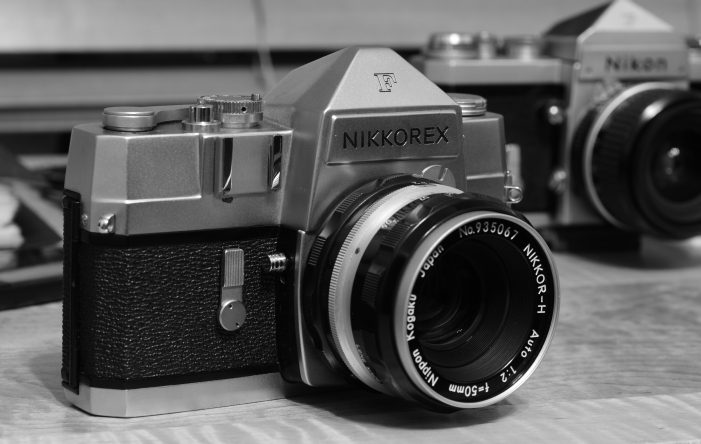
So in 1962 we get the Mamiya made Nikkorex F which would serve as the entry level F mount Nikon until the in house Nikkormat FT arrived in 1965.
So How does Ricoh get Involved ?
Ricoh had a huge success during the 1950’s TLR boom but unlike other rivals was ill prepared for the SLR boom triggered by cameras like the Nikon F. So Like Nikon they turned to a rival to help.
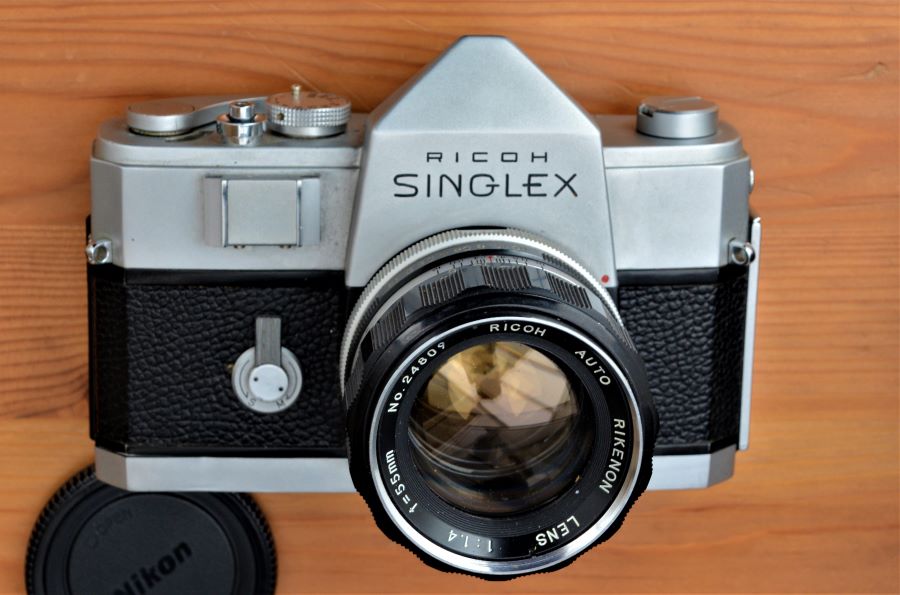
Mamiya happily sold them the same design. It’s unknown if Mamiya made the cameras or if Ricoh did it in house. Ricoh had the sense to rebrand to the US department store Sears. The camera can be found branded as the Sears SL11. However be aware for some unknown reason, a Sears SL11 can also be a rebranded Ricoh Singlex TLS. That’s a TTL metered M42 screw mount body (easily spotted by the combo shutter speed/ISO dial on the front.
Ricoh would launch their first own in house SLR with the 1963 Ricoh 35 Flex. This and the later 35 Flex CdS have fixed lenses and a leaf shutter. They would be replaced quickly by the much more practical Singlex TLS.
But the original Singlex had one crucial difference to the Nikkorex. ..
Nikkorex F/Singlex Design & Features
Mamiya pulled a blinder here.
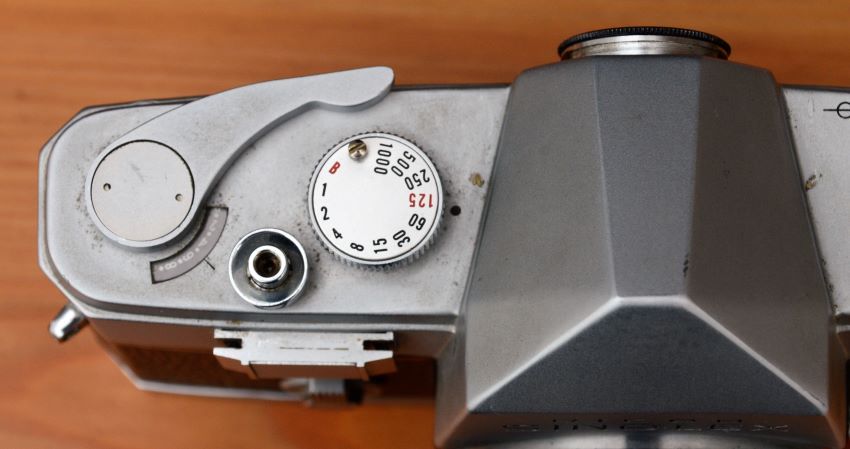
On one level they kept to the brief of a simpler camera than the Nikon F. Corners are cut. So you don’t get any modularity here like interchangeable finders or focus screens. Nor can you stick on a motor drive or bulk load back. The mount locking pin set up is more cheaply made (although still reliable) and sits unusually at 5 O’Clock. And there is no TTL but that was just becoming a thing,

But it is well built. It has has a similar layout to the Nikon F and most manual cameras to follow with a shutter speed dial on the top plate. But weirdly the camera has some refinements over the Nikon F !
It was the first Nikon SLR to have a vertical focal plane shutter (and the first SLR full stop to have a vertically travelling metal copal one). The mechanical shutter offers 1sec to 1/1000 in full stops plus a bulb mode. It flashed sync’d at 1/125 faster than the Nikon F. It’s also the first F mount camera with a hinged back (although arguably the Nikon F door made other accessories that bit easier).
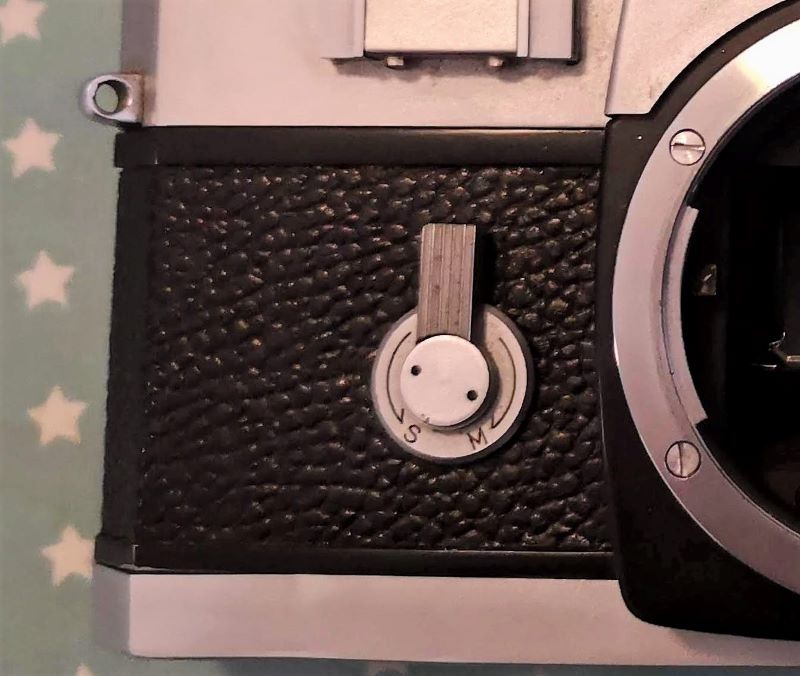
The camera has a DoF preview & mechanical self timer (or as I like to call ’em lever of doom) lever and has standard tripod and cable threading. Whilst the Nikkorex F has separate lever for time and DoF button the Singlex incorporates both into the lever.
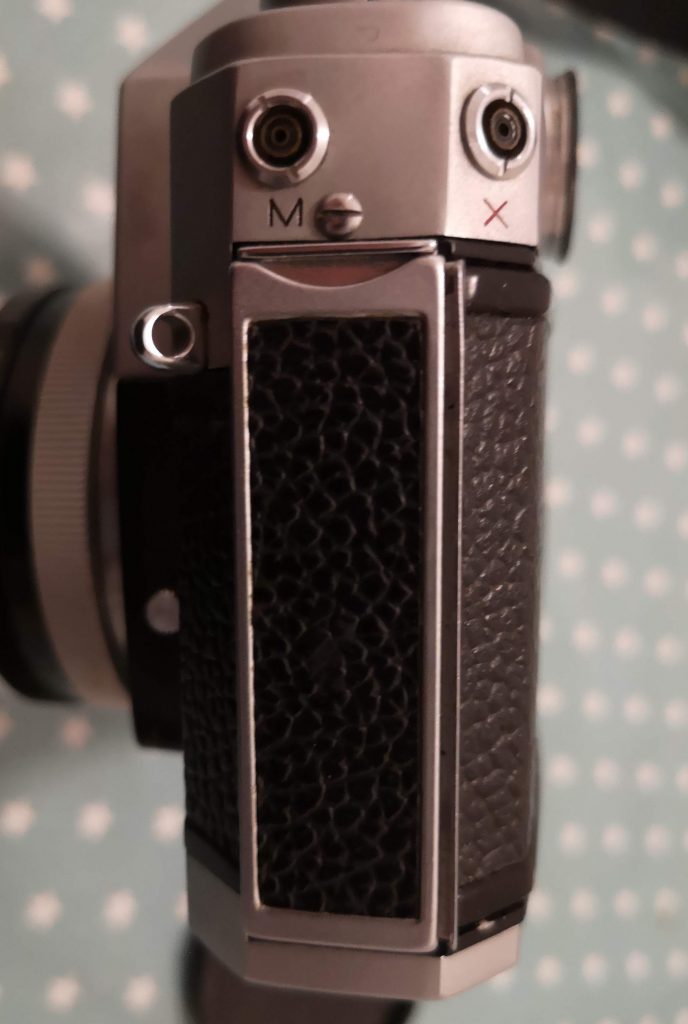
On the side you have a PC sync point for X & M flash. A slip on cover over the pentaprism had a cold shoe for flash. Sounds backward but Nikon SLRs suffered from this until the FT2 in the 1970’s. The Nikon F2 and bizarrely the 1980 Nikon F3 lacked a hot/cold shoe.
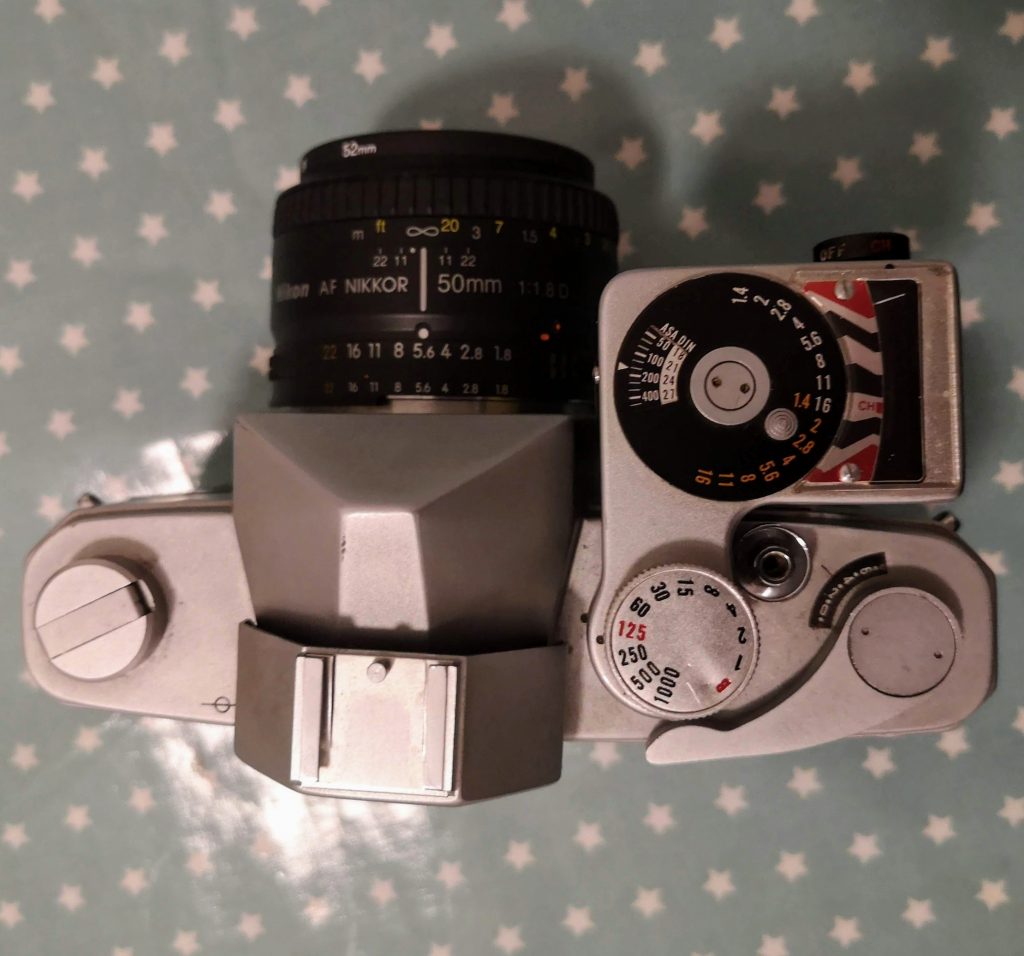
The viewfinder is actually quite big and bright for such an early SLR. The non changeable screen is good but no Nikon K2. There a horizontal split surrounded by a microprism collar.
There is nothing else in the viewfinder. the camera is completely mechanical. The only wires are for the flash circuits. This makes these potentially very reliable as solidly built but no risk of electronic failures or battery leakage. There is of course no metering
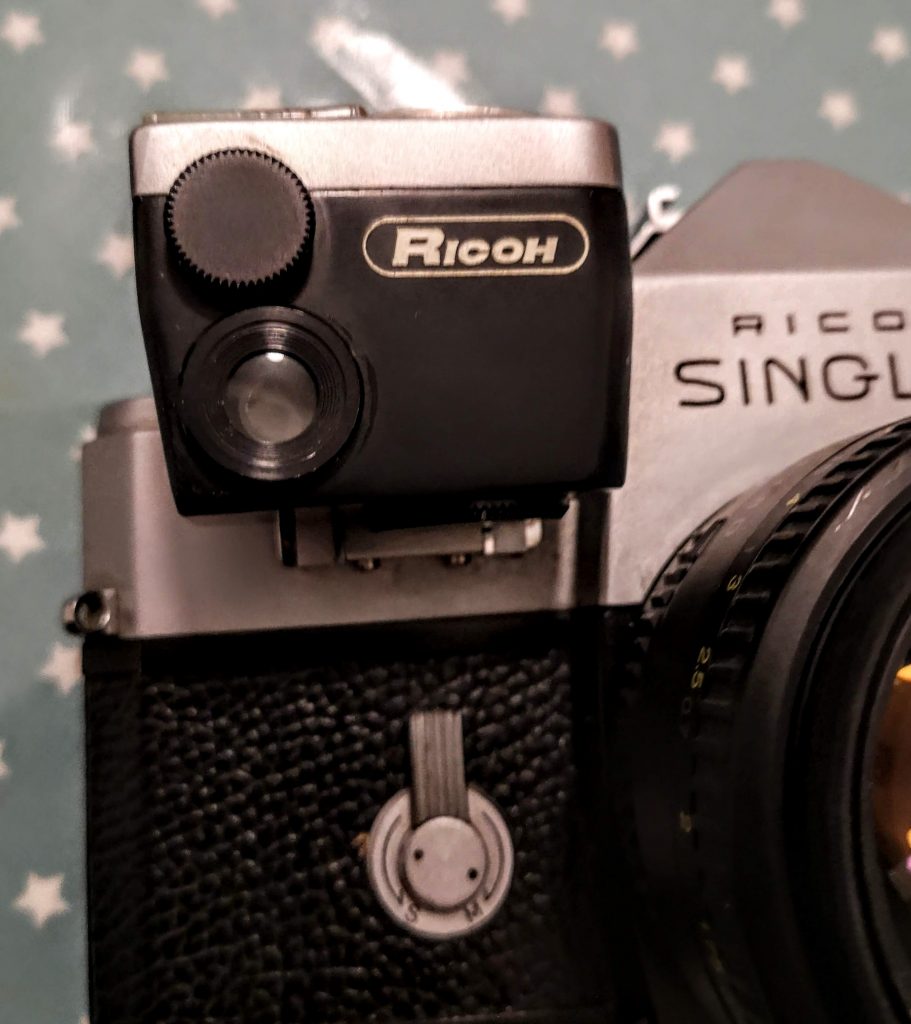
The Nikkorex F was sold with an optional clip on external selenium meter. This slides down the odd accessory shoe and the front and locks onto the shutter dial. It adjust the readout to your changes in shutter speed giving you the aperture to set. The Singlex has a CdS one (both can be interchanged between the models).
But that isn’t the major difference
Lens Mount – Compatible but Different
Both these cameras will mount most Nikon F mount lenses. There are a few exceptions like the Invasive fish eyes (you’d need a mirror lock up and the shutter box front plate prevents entry). The cameras can mount vintage lenses from 1959 up to modern digital AF lenses. As there is no metering you can actually fully use most lenses as long as they have a Aperture ring. This means you can use not just vintage pre-AI lenses, AI lenses but also even some in production AF lenses. My Nikkor 50mm 1:1.1.8 AF-D feels quite at home on my Singlex.

With G lenses that lack a aperture dial you are stuck in the smallest aperture but if you can live with that you can shoot with ’em. The only lens you’d be stuck with are the AF-P which don’t allow you to focus.

That’s quite a feat although a few later cameras like the FE, FM & Nikkormat models allow you the same capability (unmetered or stop down metered). It even mounts my Kiev 19′s Helios-81N (гелиос-81н ) 50mm 1:2 lens without fuss.
But here’s the thing. the Singlex looks like it has a Nikon F mount. And yes it will mount Nikon lenses but it is different…..
The Singlex Mount and Lenses
Look at this shot of the Singlex and a Nikon FE.
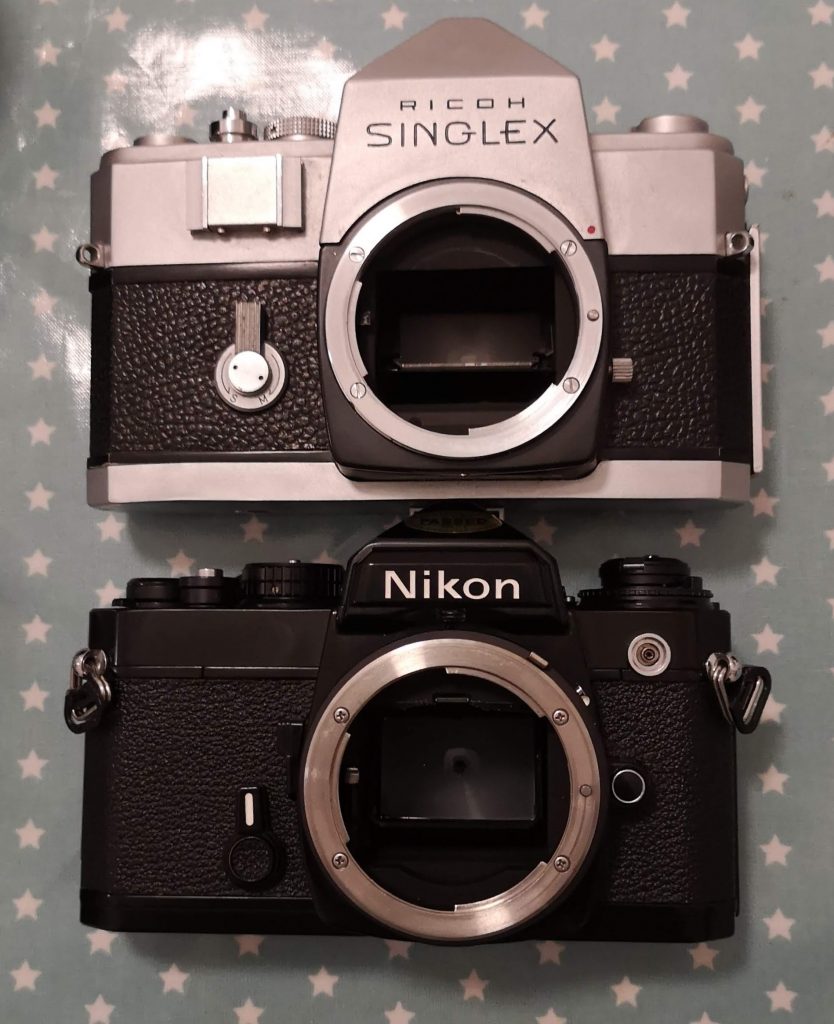
Notice the phalanges on the mount plate at around 10 O’Clock. Ricoh Singlex one is shorter. Not so short that a Nikon lens couldn’t be mounted securely but enough for this to be a subtly different mount. But the reverse as a rule can’t be said.
Whilst a few folk claim to have successfully mounted these lenses on an early Nikon body, it doesn’t sound easy and certainly it wasn’t happening on either my Nikkormat FTn, FE or Kiev 19.
Ricoh created 3 lenses with this mount. As one of the the lens bayonet phalanges is bigger it can’t fit on a standard F mount. Oddly some adaptors for F mount to digital CSC cameras however do seem to fit as is the case with my micro 4/3 adaptor as shown. The lens is useable here in AP mode and manual but there is no focus assist.
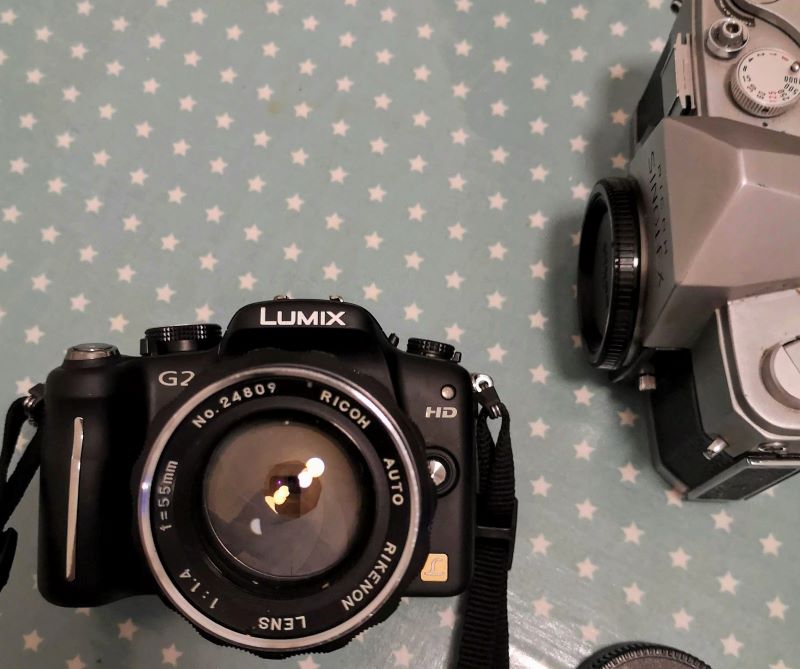
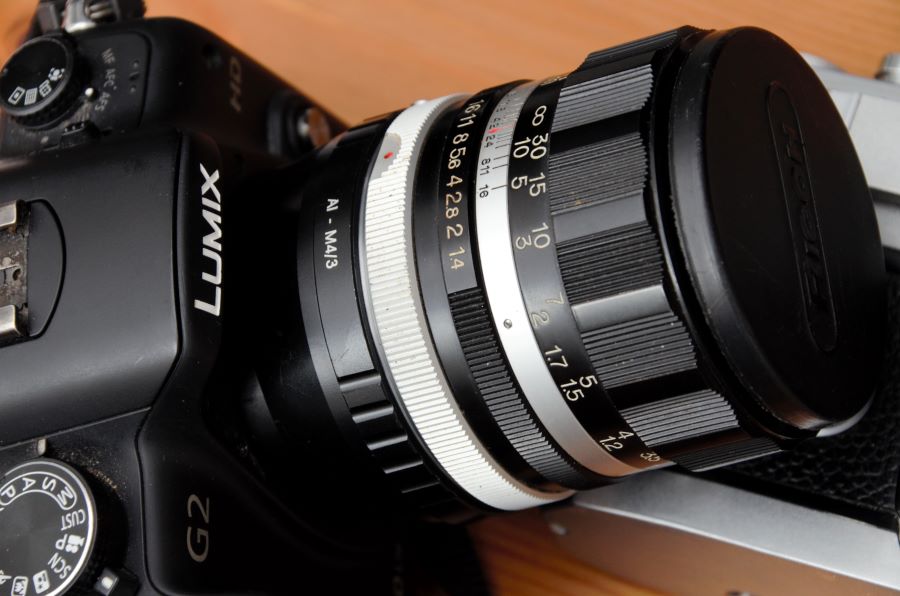
The kit lens was the Auto Rikenon 55mm 1:1.4 pictured above. I can’t get much precise on this coated lens but it is likely similar to the 1965 M42 lens on the Singlex TLS. That’s a coated 6 element 4 group (? Planar config) with 6 aperture blades.
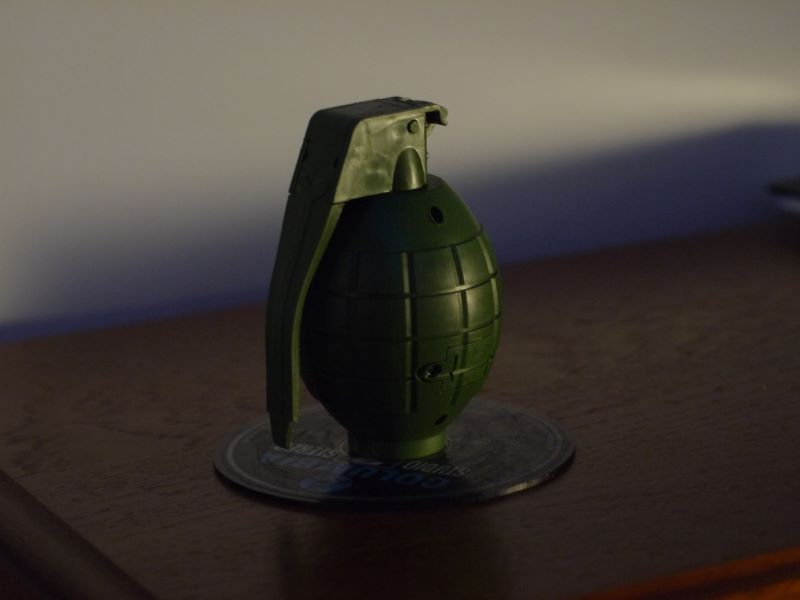
Its a nice vintage lens and I’ll hopefully review it more fully when the days brighten and I can get some Bokeh shots. It’s likely to flare however and my Nikkor-S 50mm1:1.4 feels a better choice
2 other lenses exist a 35mm 1:2.8 & a 100mm 1:4.3
Variations of the Nikkorex F & Singlex
The Nikkorex F varied over time. There appears to have been some sub variations but there are 2 main versions. The 1st version has a film reminder on the back door which the second one lacks. The second one was arguable cosmetically alter to resemble more the Nikon F.
There are 2 notable variation. In Germany there were potential brand name issues so the camera was sold branded as the Nikkor J. An anodised black version exists too. Both of these seem to be based on the 1st version. They are more collectable too.
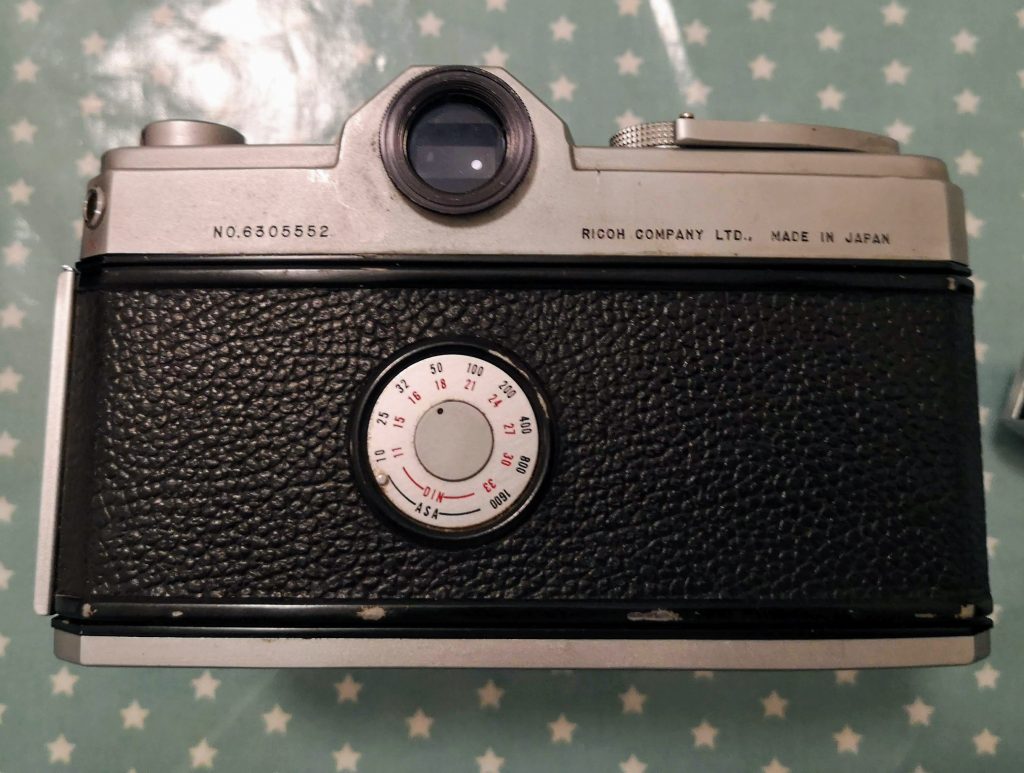
The Singlex feels like a re worked version of the 1st version. A much rarer all black version to be found. Then there’s the re-branded Sears SL 11. There’s much speculation about an ultra rare all black Sears but I suspect this is just a myth (if you come across one however you may have a a genuine rarity).
In Use
The layout of the camera is pretty much that of the archetypal Manual SLR. The simple controls & layout will be totally familiar to anyone. No metering going on and no in viewfinder info on setting. It works well on that basis. Load mirror slap but what you’d expect for something from the early 60’s.
Folk often describe it as a heavy dinosaur at 452gms without lens. So yes compared to my F75 it’s heavy. But it’s actually around 2/3 of the weight of a Nikkormat FT and lighter than a FE. It’s also half the weight of my new digital carry a D700.
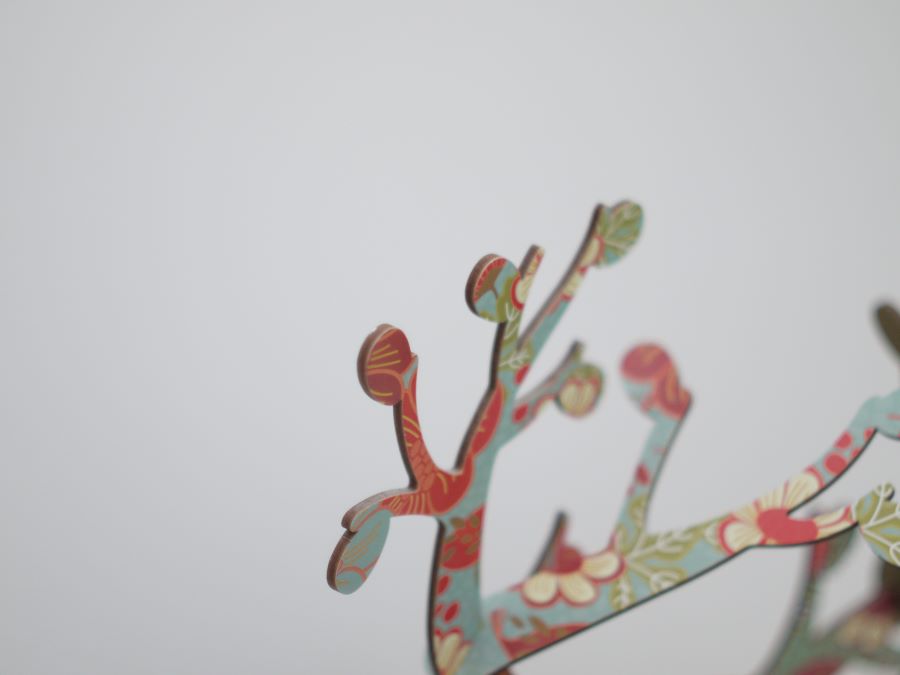
My gripes are minor.
It is an early 60’s SLR so you’ll have to live without TTL metering and all that electronic milarky to come. The Bright viewfinder tells you nothing about exposure. The shutter and mirror are a bit loud. these all relate to the era not the camera.
The accessory hood doesn’t look that stable. The DoF lever looks more vulnerable than usual (but works flawlessly almost 60 years later). There’s no mirror lock up. But then I don’t use that and in the day folk exploited the fact that the timer locks up the mirror. However as mechanical timers on vintage cameras is a bit like playing Russian Roulette 3 bullets in. I would encourage you to avoid.
Cost & Issues
Nikkorex F are more common and although collictiblend suggets they sell for a bit more than Singlex my experience is that you can get one for less. That will usually be as body only as Nikkor glass tends to add a lot. Black versions of both are way more expensive ass is the Nikkor J version.
The Sears model commands less but obviously tend to be found on sale in the US.
Mines came in at over £100 with lens, meter, accessory shoe and cases which is pretty good. You can pay more. A standard Nikkorex F can be got for between £25-75 GBP.
They’re solid machines. So the usual things like seals and mirror bumpers are what you need to be aware of. Obviously the Copal Shutter has a finite life. Richard Haw has done an excellent disassembly & Repair guide for the Nikkorex F if you need to tinker.
Alternatives
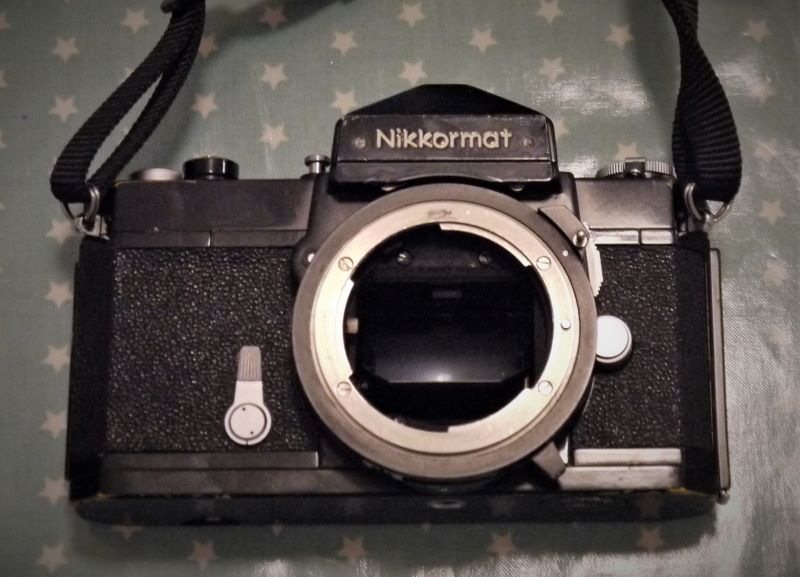
Clearly the Nikkormat Series are the obvious links. These will support a similar range of glass and with the exception of the manual only FS have metering. The FS and FT series are all mechanical. The FTn is the commonest and a bargain buy and has a slightly better meter coupling system than the FT. The FT3 offers the chance to use AI metering but is much rarer. These all have a Olympus OM like shutter ring around the lens mount which can be a bit weird to some. They would be succeed by the legendary Nikon FM.
The Nikkormat EL is more conventional in layout but much more advanced as Nikon’s first camera with an electronically controlled shutter.
Final thoughts
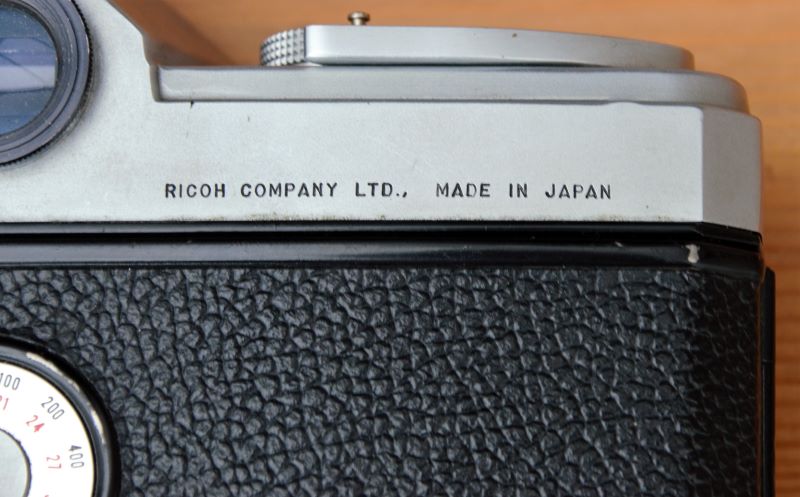
A real quirk of history this is and a lovely vintage camera to boot. There’s no major flaws although if you want metering look elsewhere. I think I prefer my Nikkormat FTn as it’s just that bit better built, has the same lens support and can coupled or stop down meter.
The singlex and Sears SL11 have that slightly different mount. If all you have is Nikon Glass, these & the Nikkorex F are pretty much identical. The Rikenon lenses are only for the Singlex and SL11 although some adaptor mounts fit it
Just watch out if buying a Sears SL11 that it isn’t a M42 mount version.
Other information
Stephen Gandy has some useful info on these on Cameraquest. The excellent Mike Butkus has manuals for both the Nikkorex F & the Ricoh Singlex. He also has a manual for a Sears SL11 but it’s the later M42 (aka Singlex TLS) version. Nico Van Dijk and Peter Lausch both cover the whole Nikkorex series and do discuss the Ricoh and Sears versions of the F.

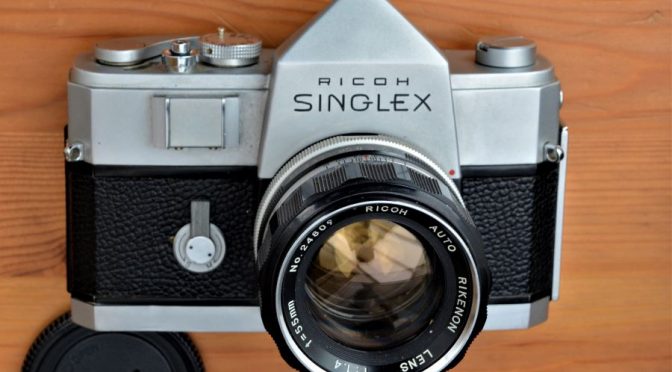
Alan, as an adjunct to your detailed article, the Mamiya NP was also badged as “Reflexa” and which I understand was mainly for the UK market where it was supplied with the Canon OM f1.9/50 as standard. This was my first ever slr and which I acquired sometime in 1966. It uses the Exakta bayonet mount but Exakta lenses with the lens aperture/shutter release can’t be mounted, and neither can the Canon lens be used on an Exakta camera. MF and pre-set aperture lenses without the standard Exakta release could be used, though.
I had 35mm and 135mm Galaxy lenses in T2 Exakta mount. Despite their budget credentials, I am surprised, even today, just how sharp the lenses were around f5.6 to f8.
I have the Singlex F, too.
Five seconds work with a Dremel sorts the cross-mount problem. I intend using the Rikenon 55 1.4 on an FE and D600, but will shoot some film with it first.
The Singlex body gives the impression of being quite well built and working flawlessly 60 years on. For some reason they have a bit of a defective reputation, but it only takes one or two owners to muddy the waters and it gets repeated ad nauseum thanks to the internet.
What I have heard, in the eightis, the black version of Ricoh Singlex was delivered to Norway only.
Thanks for a great article!
Curt Johansson
Söders Fotoservice
Sweden